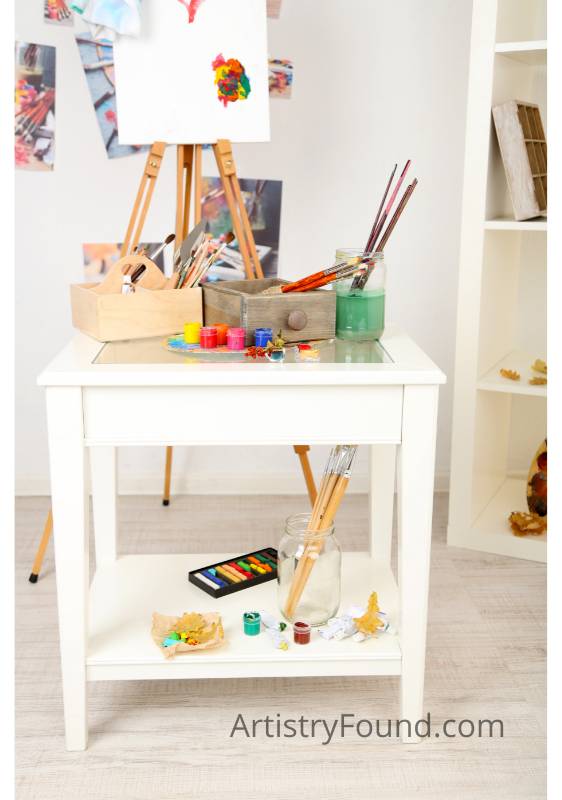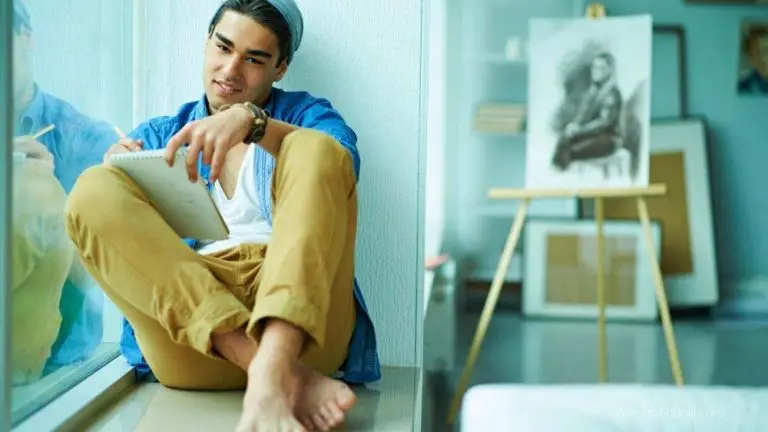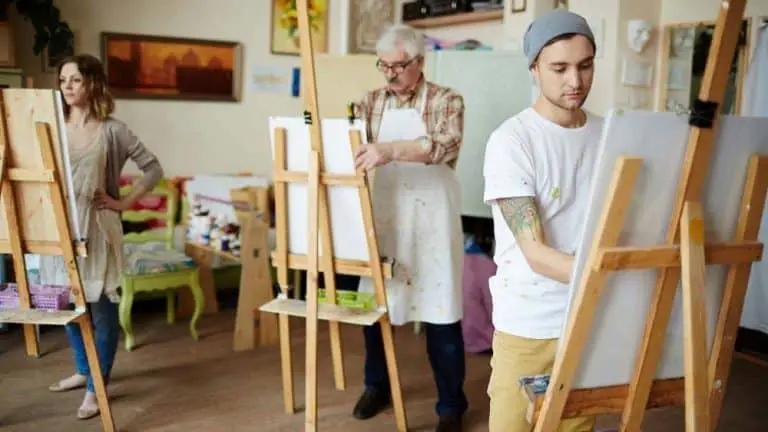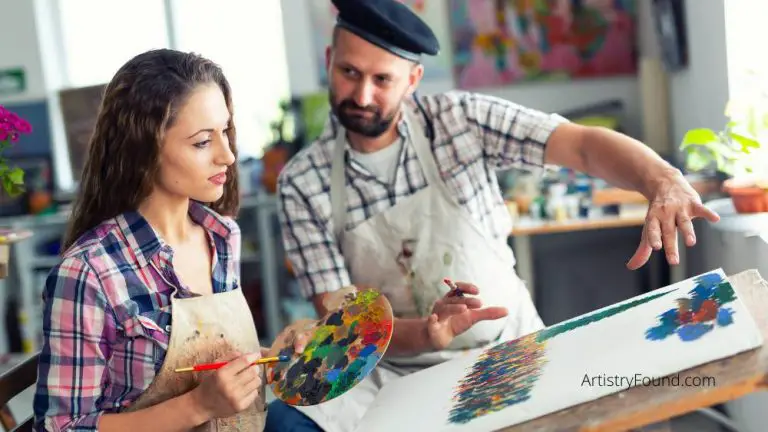What Exactly is Studio Art? (Studio Arts Major Explained)
There are many career opportunities in art and an equally large amount of art-related degrees. One of the more popular ones is Studio Art. If you’re considering a Studio Art major at a university, the first logical question would be: what is Studio Art exactly?
Studio Arts is a Bachelor of Fine Arts (BFA) degree program that involves using various visual art mediums to express human thoughts and ideas creatively. It is a good starting point for students wanting to pursue an art career and is one of the most popular art-related programs today.
Keep reading to learn all you need to know about the Studio Arts major. I’ll include the areas of study available to gain a degree in the arts, your prospective career options, and some of the top universities offering degrees in Studio Arts within the United States.
What is a Studio Art Program?

(This article may contain affiliate links and I may earn a commission if you make a purchase)
Studio Art refers to a college university program that allows students to take classes in painting, photography, graphic design, illustration, sculpting, printmaking, art history, or drawing. It is a compelling program for aspiring digital and fine artists, and the various classes give you the freedom to choose the ones you think will be most beneficial to you.
When undertaking a Studio Arts program, you will typically have an area of specialization, and that’s understandable. Nothing could be more overwhelming than having to study every aspect of digital and fine arts, all at the same time.
Studio Arts is one of the most popular visual art majors, making it into the top 30 of the most popular university majors in the United States over the last academic year.
Almost 1,500 schools are offering this program in the United States alone, and they award about 30,000 degrees per year. These statistics show that Studio Art is one of the most rewarding programs in universities today, and it’s quite popular amongst students.
Type of Studio Art Degrees
Just like most other degrees, there are different types of Fine and Studio art programs you can take, each with varying levels of importance. Here are some of the Studio Art programs that most universities offer and some basic information about each.
1. Associate of Fine Arts Degree
The Associate of Fine Arts Degree (AFA) is the most basic Studio Art degree program. It requires about 60 to 70 credit hours to complete, depending on your chosen institution, and it takes about two years to complete.
2. Bachelor of Fine Arts Degree
The Bachelor of Fine Arts Degree (BFA), sometimes referred to as a Bachelor of Visual Arts (BVA), is one of the most common liberal arts course programs for Studio Art majors. It requires 120 credit hours, and it takes a much longer four years to complete, just like any standard Bachelor’s Degree Program.
Important: If you’re pursuing a Studio Arts degree, it’s advisable to get a Bachelor’s Degree at least, as more than 50% of people working in fields relating to fine arts have a degree that’s equivalent to or higher than a Bachelor’s degree. You don’t want to be part of the lower half in your field.
In addition, a BFA degree is likely the right choice if you ultimately wish to pursue a career as a professional artist.
3. Master of Fine Arts Degree
Most people working in a field related to fine arts have a Master of Fine Arts Degree (MFA). Typically, you’ll need a lower degree and some work experience as a prerequisite for this type of graduate school program, but that may not be necessary, depending on which institution you’re applying to.
The MFA degree requires 50 to 70 credit hours of graduate study to pass, and it takes about one to three years to complete. The amount of time you’ll take to complete your Master’s in Studio Art depends on how much time you’re willing to invest in learning (i.e., part-time or full-time art student).
4. Doctorate of Fine Arts Degree
Some people take it even further to get a Doctorate of Fine Arts Degree (DFA) after completing their Master’s Degree. While this will make a nice addition to an already robust resume, you probably don’t need it unless you plan to teach art at a high level.
If you’re willing to go that far, you’ll need to dedicate an additional four years to get your advanced degree, at least. After getting the degree, however, you’d have become an expert in Studio Arts, placing you among the top 10% academically.
Studio Art Career Opportunities

A Studio Arts degree imparts many skills to the students. They learn various communicative, expressive, creative, and problem-solving skills that give them a wide selection of artistic career choices.
As a graduate of Studio Art, here are some of the career opportunities that you can consider pursuing after getting your degree from a qualified institution.
1. Fine Arts
Fine art is undoubtedly the most common career choice for Studio Art graduates. Most people pursue the degree program because they already have some flair for fine arts, and they’re trying to learn the more technical aspects at a formal institution.
The fine art world has many subdivisions, including photography, painting, drawing, and sculpture.
As a photographer, you can sell your photos on digital image sites like Getty Images and Alamy Stock Images or work as an assignment photographer.
Illustrators can work for a companies art department or get freelance gigs to create designs for corporations or small businesses. You can even create a successful YouTube channel to share your knowledge about fine art with the world.
2. Digital Art
Technology has advanced and is still advancing at a breakneck speed. As a result, most traditional art methods like painting on canvas and drawing on paper are slowly dying and getting replaced by digital art options, especially when it comes to business and commercial applications.
A Studio Arts graduate may focus on digital art by learning to make drawings and illustrations using computer software. They can also become animators, image manipulators, or even assist in creating software to aid artists in doing their work.
Digital artists are highly sought-after due to their versatility. For example, a digital artist may be tasked with creating a logo for a company, creating animations for commercials, or making computer-aided designs.
Related: Will Digital Art Replace Traditional Art? (Explained)
3. Art Teacher & Art Tutoring
If you have an advanced degree in Studio Art, you may consider becoming an art teacher or tutor, working at a college or university offering related courses. In most places, you may need a teaching qualification in addition to Studio Art to be allowed to become a faculty member in a public or private school setting.
Teaching is best for Studio Art graduates with excellent communication skills and a drive to inspire the younger generation to pursue an art-related career.
Suppose you don’t have the required qualifications to teach as a professional art educator. In that case, you may consider getting some additional experience by teaching art during a summer session or volunteering to assist with extracurricular educational arts programs.
Top Studio Arts Degree Programs in the U.S.
If you wish to acquire an undergraduate or graduate degree in Studio Arts, you’ll be excited to know that it’s quite likely that there is a school with a studio arts curriculum near wherever you live. There are hundreds of colleges and universities in the U.S. that offer studio art courses.
Here is a list of the top 10 schools offering Studio Arts degrees in the United States:
- Stanford University
- University of Notre Dame
- Duke University
- Cornell University
- Colgate University
- University of Michigan – Ann Arbor
- Vanderbilt University
- Lafayette College
- Dartmouth College
- Carnegie Mellon University
Don’t despair if these seem too far away or out of your budget range. Almost every medium-sized or larger city has one or more schools that offer a Studio Arts program.
Final Thoughts
Majoring in Studio Arts can be a good choice if you’re looking to get an art education while also earning a formal college degree. The major will provide a somewhat broad education in the arts that will be applicable to a wide variety of career opportunities.








